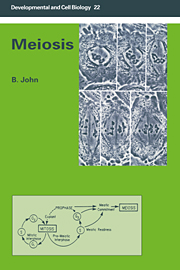Book contents
- Frontmatter
- Contents
- Acknowledgements
- Prologue
- 1 Introduction – multiplication and division
- 2 Modes of meiosis
- 3 Occurrence and timing of meiosis
- 4 Events and mechanisms of meiosis
- 5 Chromosome disjunction
- 6 The genetic control of meiosis
- 7 Sequences and consequences of meiosis
- 8 Evolutionary aspects of meiosis
- Postlogue
- References
- Index
3 - Occurrence and timing of meiosis
Published online by Cambridge University Press: 21 January 2010
- Frontmatter
- Contents
- Acknowledgements
- Prologue
- 1 Introduction – multiplication and division
- 2 Modes of meiosis
- 3 Occurrence and timing of meiosis
- 4 Events and mechanisms of meiosis
- 5 Chromosome disjunction
- 6 The genetic control of meiosis
- 7 Sequences and consequences of meiosis
- 8 Evolutionary aspects of meiosis
- Postlogue
- References
- Index
Summary
There must be a form of nuclear division in which the ancestral germ plasms contained in the nucleus are distributed to the daughter nuclei in such a way that each of them receives only half the number contained in the original nucleus.
August WeismannDIFFERENTIATION OF THE GERM LINE
In the late 1800s it was widely accepted that the germ cell line of animals was continuous from one generation to the next. Weismann(1892), however, proposed that the true continuity was provided not by the germ cells as such but by a nuclear substance handed down from parent germ cells to those of the offspring. He termed this substance germ plasm. In the early 1900s Hegner succeeded in tracing cytoplasmic granules from the pole plasm of insect oocytes of one generation to the germ cells of the next generation (Hegner, 1914). He referred to these granules as germ line determinants and argued that they were the visible expression of a specialized differentiation in the cytoplasm which controlled the production of the primordial germ cells.In Hegner's terms, therefore, the germ plasm was cytoplasmic in character and not nuclear, as Weismann had assumed. Time has confirmed the essential accuracy of Hegner's ideasand it is now clear that there is no difference in principle between the differentiation of the germ line and the differentiation of the various categories of somatic cells.Germ cells are simply cells specialized for meiosis and sexual heredity.
In most metazoans there is a clear division of labour between the cells responsible for sexual reproduction, the germ line cells, and the somatic lineages of the organism. The mode of origin of the germ cells is, however, varied and the differentiation between soma and germ line is not always abrupt.
- Type
- Chapter
- Information
- Meiosis , pp. 103 - 112Publisher: Cambridge University PressPrint publication year: 1990



